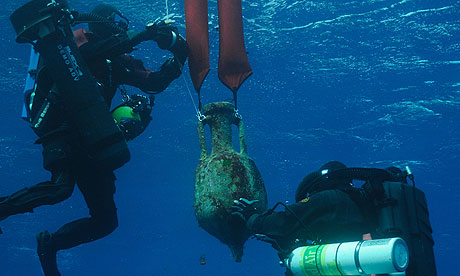Return to Antikythera: what divers discovered in the deep

Divers revisiting the wreck in Greece where an ancient computer was found have discovered an array of artefacts
• Antikythera shipwreck: treasures from the deep – in pictures
Share 1370
inShare1
Email
Antikythera shipwreck expedition : Divers recover an amphora
Divers recover an amphora from the site of the Roman Antikythera shipwreck in Greece. Photograph: Hellenic Ephorate of Underwater Antiquities/WHOI
Divers returning to the site of an ancient wreck off the Greek island of Antikythera have found artefacts scattered over a wide area of the steep, rocky sea floor. These include intact pottery, the ship's anchor and some puzzling bronze objects. The team believes that hundreds more items could be buried in the sediment nearby.
The Antikythera wreck, which dates from the first century BC, yielded a glittering haul when sponge divers discovered it at the beginning of the 20th century. Among jewellery, weapons and statues were the remains of a mysterious clockwork device, dubbed the Antikythera mechanism.
Bar a brief visit by the undersea explorer Jacques Cousteau in the 1970s (featured in his documentary Diving for Roman Plunder), no one had visited the wreck since, leading to speculation about what treasures might still be down there. The locals told tales of giant marble statues lying beyond the sponge divers' reach, while ancient technology geeks like me wondered whether the site might be hiding another Antikythera mechanism, or at least some clues as to whom this mysterious object belonged to.
Cue all-round excitement when in October last year, a team of divers led by Brendan Foley of Woods Hole Oceanographic Institution and Aggeliki Simossi of Greece's Ephorate of Underwater Antiquities, went back for a proper look. The divers used James Bond-style propulsion vehicles equipped with high-resolution video cameras to circumnavigate the island at about 40 metres depth. Now the photos released by the team show some of what they found.
For centuries Antikythera was in a busy shipping lane, but surprisingly its treacherous underwater cliffs and reefs are not littered with sunken ships (perhaps those ancient navigators were more skilled than we thought). And there are no obvious signs of a wreck at the site supposedly excavated by Cousteau, suggesting that he recovered all of the visible items there – or that he planted some of his finds for the cameras.
But 200 metres away, the divers found artefacts spread across the rocky sea floor, on a steep slope between 35 and 60 metres deep.
The largest item recovered was a huge lead anchor stock. It was lying on a semicircular object that might be a scupper pipe, used to drain water from the ship's deck. If so, the ship may have gone down as she was sailing with the anchor stowed. The team also raised an intact storage jar (amphora), which matches those previously recovered from the wreck. DNA tests may reveal its original contents.
Most intriguing are dozens of irregular spherical objects sprinkled across the wreck site. They look like rocks but contain flecks of green, suggesting small bronze fragments, corroded and encrusted in sediment after thousands of years in the sea. This is just what the Antikythera mechanism looked like when it was discovered. Then again, they could be collections of ship's nails.
Because the artefacts the team found are a short distance from the site investigated by Cousteau, it's possible that they belong to a second ship from around the same date as the original wreck, perhaps part of the same fleet. But Foley thinks it more likely that all of the remains come from one vessel that broke up as it sank.
To confirm this, he hopes to revisit the site later this year. He wants to use metal detectors to map the distribution of metal and ceramic objects buried beneath the surface, as well as dig a few test trenches. "I'm intensely curious about what's in the sediments," he says.
Cousteau only excavated a few square metres of the site but that was enough to reveal more than two hundred items, including jewellery, coins and small bronze statues. But while previous visits to the wreck have been little more than salvage expeditions, Foley says he'd love to carry out a systematic, scientific excavation of the wreck site, if he can find anyone to sponsor him: "As soon as we have the money we'll be back."
• Jo Marchant is author of Decoding the Heavens, a book about the Antikythera mechanism. Her next book, The Shadow King, will be published in June.
http://www.guardian.co.uk/science/blog/2013/mar/18/return-to-antikythera-divers?INTCMP=SRCH